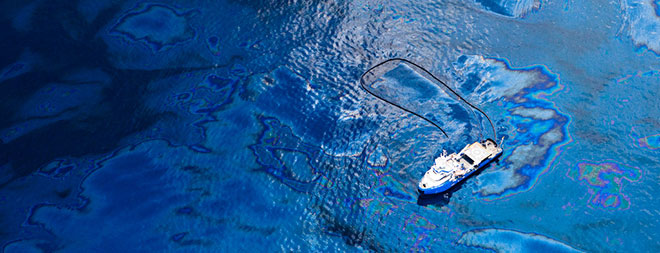Polymer Solutions News Team – Oil spills unfortunately are part of the reality of our modern industrial age. Thousands of oil spills are reported annually in the United States. In the worst spill in American history, the Deepwater Horizon rig leaked 4.9 million barrels (210 million gallons) of oil in 2010, resulting in $400 million in criminal fines and penalties, and an estimated $7.8 billion to be paid for claims made in Louisiana, Mississippi, Alabama, Texas, Florida and adjacent Gulf waters and bays. But environmental damage can’t be only counted in terms of money.
Since oil floats on water, marine oil spills contaminate water over vast areas, restraining marine species in their natural habitat and food supply, and leaving residue on the surrounding ecosystems. If not stopped offshore, an oil spill may contaminate coasts and coastal soil areas, which are even more difficult to clean.
According to the Environmental Protection Agency (EPA), oil spill response techniques include mechanical containment (booms, barriers, and skimmers, as well as natural and synthetic sorbent materials) to capture and store the spilled oil until it can be disposed of properly. Chemical methods, including dispersing and gelling agents, are used to keep oil from reaching shorelines, while biological agents have potential to assist recovery in sensitive areas such as shorelines, marshes, and wetlands.

To aid in leftover oil collection, a team of scientists from Texas A&M University, led by chemist Karen L. Wooley, have developed a “magnetic nanobroom,” polymer mesh-coated iron oxide nanoparticles that can hold up to 10 times their weight in oil. Here’s how an article in Canadian Plastics describes the invention:
“To simulate an actual oil spill, the Texas A&M team weathered a sample of crude oil to match the conditions of the Deepwater Horizon spill. When the nanoparticles were dropped in the oil-water mixture, they immediately changed color from light tan to black as they soaked up the oil. It gets better: When the nanoparticles were full they floated to the top, making for easy recovery by a conventional magnet.”
To remove the collected oil, the nanoparticles are sonicated in ethanol and can be reused. This exciting work, “Robust Magnetic/Polymer Hybrid Nanoparticles Designed for Crude Oil Entrapment and Recovery in Aqueous Environments,” was published in ACS Nano in August of 2013. The nanoparticles consist of magnetic iron oxide core surrounded by crosslinked amphiphilic polymer poly(acrylic acid)-block-polystyrene, possessing both hydrophilic acrylic and hydrophobic styrene groups, which interact with aliphatic hydrocarbons and aromatic components present in crude oil.
This work is a fine example of a rational product design, based on accurate material selection: magnetic particles are widely used as separation media, while amphiphilic polymers have many applications in medicine, mimicking hydrophobic biological structures hidden under hydrophilic water-loving outer layers. Metal-core nanoparticles have been previously reported suitable for energy storage. To further address environmental problems, the next step would be to make these nanoparticles biodegradable so that they do not create additional contamination if not collected completely.
Since humanity can’t go back in time and stop using oil for industrial and transport needs, we need to be prepared to deal with the consequences and the changes we create. As Goethe said: “Life belongs to the living, and he who lives must be prepared for changes.”
Source: Soaking up crude oil spills with polymer mesh magnetic nanoparticles, Canadian Plastics, Jan. 9, 2014
Source: Robust Magnetic/Polymer Hybrid Nanoparticles Designed for Crude Oil Entrapment and Recovery in Aqueous Environments, A. Pavía-Sanders et al., ACS Nano, 2013, 7 (9), pp. 7552–7561, DOI: 10.1021/nn401541e, Aug. 29, 2013
Source: Texas A&M Chemist Developing Small Solutions for Big Problems, Hutchins Shana, TEXAS A&M UNIVERSITY, Oct. 21, 2013
Source: Oil Spills Fast Facts, CNN Library, Oct. 5, 2013
Source: Oil spill facts, interestingenergyfacts.blogspot.com, Nov. 2, 2011
Source: Environmental Impact of the BP Oil Spill, Deja Dragovic, Living Green Magazine, March 19, 2013
Source: Oil Spill Response Techniques, epa.gov, Emergency Management
Quote by brainyquote.com
